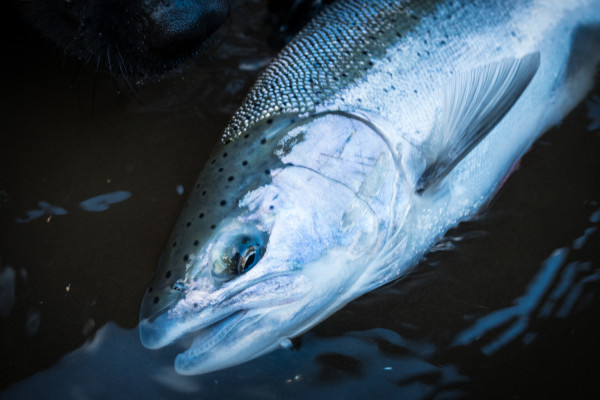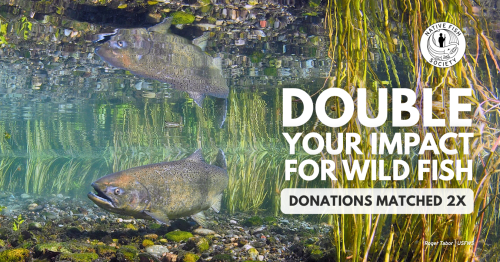Our goal is to secure catch and release regulations for wild steelhead in southwest Oregon.
UPDATE: Recently, Oregon Department of Fish and Wildlife released the public draft of the Rogue South Coast Multi-Species Management Plan. In this plan they are PROPOSING WILD HARVEST. Please follow this link to the action alert to ask the department to move forward with Catch and Release Angling until they have an estimated adult population abundance.
Across their native range, there are twelve rivers in the lower 48 states and Canada where sport anglers can still legally harvest wild steelhead. All twelve of these rivers are in Oregon, and ten of those rivers are in the Southwest Zone. Legally, sport anglers can harvest wild winter steelhead in the Rogue, Chetco, Elk, East Fork Coquille, Illinois, Pistol, Sixes, and Winchuck rivers and Hunter and Euchre creeks.
Campaign Background
In southwest Oregon, longtime local anglers and guides have noticed a decline in numbers and size of wild steelhead returning to their waters. Starting in early 2018, Harvey Young of Fishawk Guide Service started a petition for anglers of all gear types to generate support asking the Oregon Department of Fish and Wildlife for a moratorium on wild steelhead harvest in the southwest corner of the state.
When Harvey reached out asking for support, we connected him with River Stewards in the area to get an understanding of what level of impact they were witnessing in their homewaters. We all shared concern over the lack of a management plan, inadequate funding to monitor the status of wild steelhead, and an increase in angler effort in the area.
Sport fishing is the lifeblood of southwest Oregon during the winter months. Unfortunately, history has demonstrated that agencies often permit harvest of wild populations to the point of critical conservation concern, and then close fishing all together to try and rebuild a struggling run. Given the dramatic decline of wild steelhead across the Northwest, we argue it is in the best interest to take a precautionary approach to protect these iconic wild fish, before populations collapse, while still providing fishing opportunity.
In June, Harvey submitted a written petition signed by 655 anglers, with over 70% coming from local southwest Oregon anglers, and the remaining as traveling anglers who visited the area to fish. In September, he added more than 3,000 electronic signatures from anglers across the region who want to see a moratorium on wild steelhead harvest to ensure we protect these iconic fish before we are left to rebuild a recovering population.
Their petition (available here on the ODFW website) cited numerous reasons why catch and release for wild steelhead would benefit anglers and businesses in southwest Oregon, but the main points were grounded in the fact there is not a good understanding of the status and recent trends of wild steelhead in southwest Oregon.
First, for the majority of rivers (8 out of 10) where wild steelhead harvest is still allowed in the SW zone, ODFW has no management plan, and monitoring has been dramatically reduced due to inadequate funding and increased demands elsewhere in the state. The East Fork Coquille and Sixes rivers are managed under the Coastal Multi-Species Conservation and Management Plan, which was adopted by the Commission in 2015. Concerns remain on whether the department is meeting their agreed upon 10% harvest threshold for wild steelhead that was set and adopted by the Commission in 2015. The best available science suggests a harvest rate of no more than 10% of fish that can spawn multiple times like steelhead to protect their diversity and resiliency (Fujiwara, 2011).
Second, in the absence of good empirical data and adequate funding for monitoring, fisheries managers across the Northwest have implemented catch and release regulations, which has proven to be an effective management tool that still provides fishing opportunity for sport anglers. For instance, catch and release regulations for wild steelhead are already in place for almost every river in Oregon outside the Southwest Zone (except the Salmon River and Big Elk Creek), including the Willamette, Central, and Northeast Zones, and have existed in British Columbia, and Idaho since the 1980s, in California since 2010, and in Washington since 2015. In SE Alaska, in an effort to protect the resource, the department went to a 36" minimum limit for anglers to harvest any steelhead, which despite issues with size-selection bias they believe protects more than 95% of the population from harvest.
The National Marine Fisheries Service has identified 15 Distinct Population Segments for steelhead trout across their native North American range. Of these populations, over 70% (11/15) have been listed under the federal Endangered Species Act (Behnke, 2010). In Oregon, six Distinct Population Segments for steelhead have been identified and four of those are listed under the federal Endangered Species Act because populations have crashed warranting protection by federal law.
Broadly speaking, wild steelhead across their native range are in decline, and the majority of populations require further protection under federal law.
While wild steelhead in southwest Oregon are not currently listed, where available ODFW's own data has identified declining numbers of adult returns in the Southwest Zone, and monitoring has been dramatically reduced as a result of funding limitations. At the same time, an analysis of wild steelhead catch records in the Southwest Zone (below) obtained through a public records request, showed that between 2005 and 2016 wild steelhead harvest continues to increase, with some rivers increasing up to 1200% (Elk R.) and 650% (Sixes R.) in the short timeframe.
In September 2018, Native Fish Society and a coalition of anglers, businesses, and other non-profits presented testimony to the Oregon Fish and Wildlife Commission outlining our concerns and requesting that they implement a moratorium on wild steelhead harvest. We presented information about the lack of adequate data to support existing regulations. According to the Native Fish Conservation Policy, "When faced with scientific uncertainty concerning fish management, including status assessments and the effectiveness of recovery strategies, the Department shall proceed with precautionary strategies scaled to the Conservation risk".
Given this mandate and inadequate funding to support the monitoring necessary to understand the current level of harvest impacts, we asked that the department take a precautionary approach to wild steelhead management. Ultimately, the Commission unanimously voted to decrease the annual harvest limit from 1 wild steelhead per day, 5 per year to 1 wild steelhead per day, 3 per year, and directed the department to develop a Conservation Plan to study the issue further. We will continue to advocate for wild steelhead by ensuring the department moves forward with those directives in the coming year.
Implementing catch and release regulations for wild steelhead in the Southwest Zone would be the most cost-effective, equitable, and easy to implement management action to protect these important world-class populations from over harvest.
Our goal is to ensure that populations flourish, not just survive, in southwest Oregon, and we're looking for your help to join us in this effort.
How you can help:
- Please sign and share this online petition.
- Ask your city council, local fishing shop, and fishing club to write a letter in support of wild steelhead release and send them to Native Fish Society, 813 7th St. Suite 200A, Oregon City, OR 97045.
- If you own a business that depends on wild steelhead, write a business letter in support of wild steelhead catch and release and send them to Native Fish Society, 813 7th St. Suite 200A, Oregon City, OR 97045.
- Stay tuned for presentations and events this winter in SW Oregon. Contact jake@nativefishsociety.org to schedule a presentation in your area.
- Put a wild steelhead catch and release sticker on your vehicle and boat to show your support (coming soon).
You can see the comments we submitted to the Oregon Fish and Wildlife Commission below:

